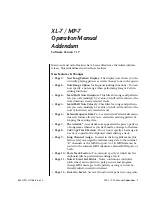
4
Trampoline Safety and Accident Prevention
As in most recreational sport, participants may be injured. This section covers the most
common accidents. Responsibilities of the supervisors and jumpers in accident prevention
are also outlined.
The following are reasons why accidents happen:
•
Attempting somersaults. Landing on the head or neck can cause serious injury, paralysis,
or death, even when landing in the middle of the bed.
•
More than one person on the trampoline. Use by more than one person at the same
time can result in serious injuries.
•
Incorrect mounting and dismounting. Carefully crawl out of and into the trampoline bed.
Do not jump off to the ground. Do not jump from a roof, or other object onto the trampoline.
Small children may need assistance to get on or off the trampoline. Do not step onto the
suspension system.
•
Hitting the frame. Stay in the center of the trampoline when jumping. Injury may result
from hitting the frame when control is lost. Be sure the frame cover is always on and the
pads securely fastened. Do not jump directly onto the frame pad.
•
Loss of control. A jumper who looses control will increase his/her chance of injury. Be
sure to familiarize yourself with the basic jumps before doing more difficult ones. Jumps
should be mastered, performed repeatedly before moving on to the next level. To regain
control and stop your jump, bend your knees sharply as you land.
•
Alcohol and drug use. Because alcohol and drug use impairs the jumpers' coordination,
loss of control as well as injuries are greatly increased.
•
Foreign objects. Please make sure there is nothing sharp under and around the trampo-
line. Hitting objects under the trampoline can cause injury. Jumping with a foreign object
can also increase the chances of getting injured. Be sure there is adequate clearance 24
feet above and 10 feet around the trampoline. Be careful of overhead wires, tree limbs etc.
•
Bad weather. Do not use your trampoline in gusty winds or inclement weather. The bed
should not be wet.
•
Poor maintenance of the trampoline. Make sure you inspect the trampoline before
every use. Check for punctures on the bed, sharp burrs on the frame, stitching that has
gone bad or loose elastic bands. If a replacement part is needed, please call our hotline to
order.
•
Unlimited access. The trampoline should be covered or dis-assembled when not in use.
This will prevent unsupervised small children from using the trampoline.
The jumper must first learn all of the basic, fundamental bounces before attempting more
difficult ones. Low, controlled bounces are a good start before learning the basic landing positions
and combinations. Jumpers need to understand that control is key to a successful jump. Review
of the users' manual to learn basic techniques is a must. Following the tips in the placard is
also important. Contact a certified trampoline instructor for more information.
Owner's & Supervisor's Role in
Preventing Injuries & Responsibilities
The supervisor's role is to make sure the users know all the safety rules as well as learn
the basic, fundamental bounces. They need to enforce all the safety rules and warnings in
the manual, frame and labels. When a supervisor is not available, the trampoline may be
dis-assembled or covered to limit access. It is the supervisor's responsibility that the placard
with the Trampoline Safety Tips is placed where all jumpers are informed about the tips.
User's Role in
Preventing Injuries & Responsibilities
3
WARNING:
Use
Instructions
!
DO NOT attempt or allow somersaults on the Trampoline. Landing on the head or neck can cause serious injury, paralysis, or death,
even when landing in the middle of the bed.
Do not allow more than one person on the trampoline or inside the trampoline enclosure. Use by more than one person at the same time can result
in serious injuries.
Keep objects away which could interfere with the performer. Maintain a clear area around the trampoline. Do not allow foreign objects
or animals on the trampoline.
Use trampoline and trampoline enclosure with mature, knowledgeable supervision.
Avoid bouncing too high. Stay low until bounce control and repeated landing in the center of the trampoline can be
accomplished. Control is more important than height.
While keeping the head erect, focus eyes on the trampoline toward the perimeter. This will help control bounce.
Avoid bouncing when tired. Keep turns short.
For additional information concerning the trampoline equipment, contact the manufacturer.
For information concerning skill training, contact a certified trampoline instructor.
Do not attemp to jump over barrier or attempt to crawl under barrier.
Do not hang from, kick, cut or climb on barrier.
•
•
•
•
•
•
•
•
•
•
•
•
•
•
•
•
•
•
• Do not intentionally bounce off the barrier.
•
The trampoline should be assembled in its entirety before each use. All springs must be attached to the frame. The frame cover must be
correctly positioned at all times.
Never set-up the trampoline in heavy rain, wind or storm conditions, especially lightning storms. It is recommended that the trampoline be taken
apart and stored in bad weather.
•
Inspect the trampoline & enclosure before each use. Make sure the frame cover, barrier mesh, and enclosure support padding are correctly and
securely positioned. Replace any worn, defective or missing parts.
• The metal frame of the trampoline and trampoline enclosure will conduct electricity. Lights, extension cords, and all such electrical equipment must
never be allowed to come in contact with the trampoline or trampoline enclosure.
• Wear comfortable clothing. Remove jewelry, necklaces, and earrings. Wear clothing free of drawstrings, hooks, loops or anything that could
get caught in the barrier mesh.
Enter and exit the enclosure only at the enclosure door or barrier opening designated for that purpose. It is dangerous practice to jump from the
trampoline to the ground or floor when dismounting, or to jump onto the trampoline when mounting. Do not use the trampoline as a springboard to
other objects.
Stop bounce by flexing knees as feet come in contact with the trampoline bed. Learn this skill before attemting others.
Properly secure the trampoline when not in use. Protect it against unauthorized use. If a trampoline ladder is used, the supervisor should remove it
from the trampoline when leaving the area to prevent unsupervised acess by children under six years of age.
Do not use the trampoline while under the influence of alcohol or drugs.
Bounce only when the surface of the bed is dry. Wind or air movement should be calm to gentle. The trampoline must not be used in gusty
or severe winds. The trampoline should be taken apart or stored indoors during these types of weather conditions.
Read all instructions before using the trampoline and trampoline enclosure. Warnings and instructions for care, maintenance, and use of this
trampoline and trampoline enclosure are included to promote safe, enjoyable use of this equipment.
Do not attach anything to the barrier that is not a manufacturer approved accessory or part of the enclosure system.
•
Trampolines over 20 in. (51 cm) tall are not recommended for use by children under six years of age.
•
When moving the assembled trampoline and trampoline enclosure have at least four people evenly spaced around the frame (NSEW) to lift
the trampoline off the ground.
•
Learn fundamental bounces and body positions thoroughly before trying more advanced skills. A variety of trampoline activities can be carried out by
performing the basic fundamentals in various series and combinations, performing one fundamental after another, with or without feet bounces
between them.
Children may be entangled or strangled in loose cords or gaps between trampoline and enclosure. Keep enclosure tightly fastened
to the trampoline in accordance with the manufacturer’s instructions. Failure to properly assemble and maintain a tight, secure
trampoline/enclosure boundary may result in serious injury, strangulation or death.
•
•
























